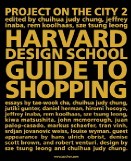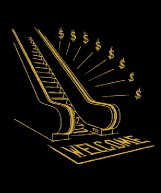Goetheno doubt inspired by European masterpiecesdescribed architecture as "frozen music." The Wal-Marts and Home Depots of today's consumption-based societies might embody instead frozen Muzak. Retail stores, breathtaking only in their warp-speed proliferation and disappearance (they last, on average, about seven years), have come to dominate urban landscapes. Furthermore, as the global economy expands, so does global consumption, and therefore shopping mallsonce monuments to a uniquely American materialismare now ubiquitous. From Xian to Chicago, there is no escape from shopping. Yet retail design is neglected by architects, who strive to build enduring masterpieces like libraries and skyscrapers, not big-box stores.
 |
| Taschen |
Thus, despite its lighthearted title, the Harvard Design School Guide to Shopping (Taschen, 2002) is no merry primer on the world's chic boutiques. Rather, this unusual 800-page book examines all things retailfrom the architecture of Niketown, Disneyworld, and airport malls to the histories of escalators, air-conditioning, and bar codesand, through essays, interviews, pages of photographs, and statistics, identifies shopping as a defining and unsightly feature of urban society. The book reveals the predatory, often dubious tactics (such as customer tracking devices and focus groups) that allow retailers to sustain consumer demand despite volatile markets and trends. And it laments the privatization of institutions like museums and airports, which have become shopping destinations. "Not only is shopping melting into everything, but everything is melting into shopping," writes Sze Tsung Leong, M.Arch. '98, an editor and contributor to the book.
The Guide to Shopping is a product of the Project on the City, a seminar led by Rem Koolhaas, professor in practice of architecture and urban design. Yearly since 1996, the project has explored a new aspect of the effects of modernization on contemporary cities from Lagos to Las Vegas. Koolhaas and his students spend a semester traveling worldwide for research (itineraries have included Singapore, Tokyo, and Minnesota's Mall of America) and then develop their findings the following term. (The research-related travel is funded partly by the design school and partly by the students themselves.)
 |
| An escalator, dollar signs, and welcome mat on the book's back cover say it all. |
| Taschen |
Such exhaustive, cross-disciplinary analysis is new to architectural pedagogy, which has traditionally emphasized building, not research. "The project falls beyond the realm of typical design studies," says design-school dean Peter Rowe. "It's a hybrid of discussion and storytelling, design and scholarship."
The Guide to Shopping integrates sociology, economics, and psychology into its examination of retail. Going beyond the physical appearances and designs of stores, the book scrutinizes ancillary features like frequent-customer cards and artificial rain forests (for example, the extensive tropical plantings inside the Mirage Casino-Hotel in Las Vegas) for their insidious roles in enticing and nurturing consumption. Air conditioning is a prime factor: "By making interior spaces larger, more comfortable, more controlled, and more difficult to escape," writes Leong, air conditioning "radically altered the way that time was spent in public."
Furthermore, cities have shifted their priorities from public interest to revenue maximization. "The marketplace is the final arbitrator and regulator of life," contends Koolhaas, who designed Prada's new flagship store in New York City and clearly believes in the possibility of worthwhile retail architecture. "Architecture now has an increasing responsibility to private interests." Privatization makes civic and social institutions like museums vulnerable to such woes of retailing as decreased consumer demand and market instabilities. "Shopping has found a way to expand by colonizing the institution," writes Leong. He cites casinos, theme parks, train stations and airports, universities, hospitals, and even military bases (such as Norfolk Naval Base, revamped as a money-making tourist attraction) as the new shopping beachheads: "The experience of the museum is becoming increasingly seamless with that of the department store."
 |
| Two for the money: retail-driven interiors at GUM, Moscow (left, built 1888-93), and The Galleria, Houston (right, 1971). |
| Taschen |
"Like a hurricane, globalization is rearranging the features of architecture," declares the oracular Koolhaas. "Architects now work in contexts, climates, and environments they know nothing about." Such clueless designers create what Koolhaas calls "junkspace"the antithesis of Goethe's frozen music. "Junkspace is what remains after modernization has run its course," Koolhaas says. Shopping malls, department stores, theme parks, golf courses, and even ballrooms are among the offenders. "Junkspace," he writes, "can either be absolutely chaotic or frighteningly aseptic...the product of the encounter between escalator and air conditioning conceived in an incubator of Sheetrock."
 |
| Shopping-mall floor plans and mall chronology from 1939 to 1996 |
| Taschen |
Koolhaas detests much of today's retail architecture and the current trends to super-size, to replicate irrelevant styles, or to dazzle for dazzling's sake. He disapproves of the hodgepodgelike Roman columns and Deco flourishesthat can jostle together in the same shopping mall. "Because we abhor the utilitarian, we have condemned ourselves to a life-long immersion in the arbitrary...[Junkspace] is flamboyant yet unmemorable," he writes. Moreover, retail space is rarely designed by so-called High Architects. When Frank Lloyd Wright, I.M. Pei, and Frank Gehry have contributed, the results can be innovative and elegant; Koolhaas might describe his own high-tech Prada store as retail done right. But generally, the discipline's stars shun such projects. "This vast lacuna...can be attributed to the widely held belief that shopping is a trivial pursuit for any self-respecting architect," writes contributor Daniel Herman, M.Arch. '98. The book's prognosis is not optimistic. "We have built more than all previous generations together," writes Koolhaas. "But...we do not leave pyramids."







